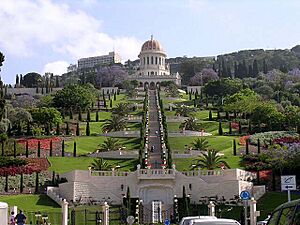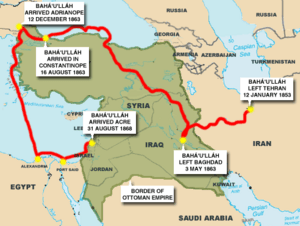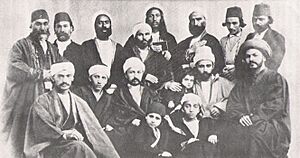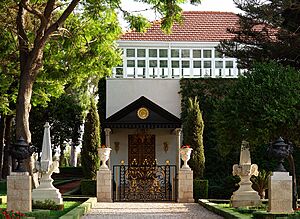History of the Baháʼí Faith facts for kids
The Baháʼí Faith is a religion that started in the 1800s. It grew from two earlier movements in Iran: Shaykhism and Bábism. Shaykhism focused on spiritual ideas, and many of its followers believed a special leader, the hidden Twelfth Imam, would return. In the 1840s, many Shaykhis joined the Bábí movement. The Báb announced that he was this promised leader.
As the Bábí movement grew in Iran, there was conflict between the Bábís and the ruling Shiʿa Muslim government. This conflict ended when government troops attacked the Bábís and executed the Báb in 1850.
The Báb had also spoken about another important figure who would come later, called "He whom God shall make manifest." Baháʼu'lláh, one of the Báb's followers, was imprisoned in 1852 during another attack on Bábís. He was then sent away to Iraq, and later to Constantinople and Adrianople in the Ottoman Empire. During these travels, in 1863 in Baghdad, Baháʼu'lláh announced that he was the promised figure the Báb had written about. Most Bábís then became followers of Baháʼu'lláh and were known as Baháʼís.
When Baháʼu'lláh passed away, the Baháʼí Faith was mainly in the Persian and Ottoman empires. He had followers in thirteen countries in Asia and Africa. Leadership then went to ʻAbdu'l-Bahá, Baháʼu'lláh's son, who was chosen by his father and accepted by almost all Baháʼís. Under ʻAbdu'l-Bahá, the religion began to grow in Europe and America. It also became stronger in Iran, where Baháʼís still face difficult times.
After ʻAbdu'l-Bahá's passing in 1921, his grandson, Shoghi Effendi, became the leader. ʻAbdu'l-Bahá had chosen him in his will. Shoghi Effendi was the first Guardian of the Baháʼí Faith. The will also called for the election of the Universal House of Justice when the Baháʼí Faith had spread enough. During Shoghi Effendi's time as leader, the number of Baháʼís greatly increased. He also oversaw the election of many National Spiritual Assemblies. The Universal House of Justice was first elected in 1963. Since then, it has been the highest governing body of the Baháʼí administration. Its members are elected every five years. Today, there are an estimated five to eight million Baháʼís around the world.
Contents
Roots of the Baháʼí Faith
Islamic Prophecies
In Islam, the Mahdi is a special leader believed to be a descendant of Muhammad. It is said he will return near the end of time to make the world and God's religion right again. Both Sunni and Shiʻa Muslims believe in the Mahdi. The largest Shiʻa group, the Twelvers, believe the Mahdi is the Twelfth Imam, Muhammad al-Mahdi. They believe he has been hidden since 874 CE.
Twelvers believe the Twelfth Imam had a "Minor Occultation" from 874 to 941 CE. During this time, he communicated through four special people. The "Greater Occultation" began when he stopped communicating regularly. It will last until he returns to fix the world.
The Shaykhi Movement
The Shaykhi movement was a group within Twelver Shiʻa Islam. It was started by Shaykh Ahmad al-Ahsá'í. Shaykh Ahmad taught that the Imams were spiritual beings, not just physical ones. He also taught that there must always be a "Perfect Shiʻa." This person would connect the Imams with believers and understand the hidden Imam. Because his teachings caused debate, he left Iran in 1822 and went to Iraq. He died in 1826 while traveling to Mecca.
Before he died, Shaykh Ahmad chose Siyyid Kázim to lead the Shaykhi movement. Siyyid Kázim led until his passing in 1843. He explained many of Shaykh Ahmad's ideas more clearly. His teachings gave Shaykhis hope that the Hidden Imam would return soon. Siyyid Kazim did not name a successor. Before his death in December 1843, he told his followers to search for the Mahdi, who he said would appear soon.
The Bábí Movement
Siyyid ʻAlí-Muhammad, who later took the title the Báb, was born on October 20, 1819, in Shiraz. His father was a merchant and died when the Báb was young. He was raised by his uncle, Ḥájí Mírzá Siyyid ʻAlí, who was also a merchant.
In May 1844, the Báb announced to Mulla Husayn, a Shaykhi follower, that he was the one Shaykh Ahmad and Siyyid Kázim had foretold. He said he brought divine knowledge. Within five months, seventeen other students of Siyyid Káẓim recognized the Báb as a special Messenger from God. These eighteen followers became known as the Letters of the Living. They were given the job of spreading the new faith across Iran and Iraq. The Báb first attracted most Shaykhi followers. Soon, his teachings went beyond those roots and attracted many important people across Iran. His followers were called Bábís.
As the Letters of the Living preached, Islamic religious leaders began to oppose them. The Governor of Shiraz ordered the Báb's arrest. The Báb was under house arrest in Shiraz from June 1845 to September 1846. He then spent several months in Isfahan, discussing with clergy. Many of them became supportive of him. One important person who accepted the Báb's message was a brilliant theologian named Vahid. He was a trusted advisor to the Shah and had been sent to question the Báb. When the Shah learned Vahid had converted, he asked for the Báb to be brought to Tehran. The Prime Minister, fearing the Shah might also be influenced, stopped the Báb's escort outside Tehran. He then ordered the Báb to be imprisoned in the distant fortress of Máh-Kú, near the Turkish border. The excuse was that the Báb's arrival in the capital might cause public unrest.
While the Báb was held in the fortress of Maku, he started writing his most important work, the Persian Bayán. He was then moved to the fortress of Chihríq in April 1848. There, the Báb's popularity grew, and his jailers eased the rules. So, the Prime Minister ordered the Báb back to Tabriz. The government asked religious authorities to put the Báb on trial for blasphemy. Bábism was spreading, and the Islamic government saw it as a threat. They even sent military forces against the Bábís. Bábí communities were formed in Iran and Iraq. By 1850, they reached several cities in Azarbaijan.
In mid-1850, a new prime minister, Amir Kabir, ordered the Báb's execution. This was likely because Bábí uprisings had been defeated, and the movement seemed to be losing popularity. The Báb was brought back to Tabríz from Chihríq to be shot by a firing squad. On the morning of July 9, 1850, the Báb was taken to the barracks courtyard. Thousands of people had gathered to watch. The Báb and a young companion named Anis were hung on a wall. A large firing squad prepared to shoot. After the order to shoot was given and the smoke cleared, the Báb was gone from the courtyard, and Anis stood unharmed. The bullets had cut the rope but not harmed either man. Soldiers later found the Báb in another part of the barracks, completely unharmed. He was tied up for execution a second time. A second firing squad was lined up, and a second order to fire was given. This time, the Báb and his companion were killed. Their bodies were left outside the town gates for animals.
However, a few Bábís rescued the remains and hid them. Over time, the remains were secretly moved through several cities to Acre, Israel in 1899. In 1909, the remains were finally placed in a special tomb built by ʻAbdu'l-Bahá on Mount Carmel in Haifa, Israel. The Shrine of the Báb is a very important place for Baháʼí pilgrims. The Shrine is a protected site and was listed on UNESCO's World Heritage Sites in 2008.
While the Báb said he brought a new message from God, he also said his message was not the final one. A constant theme in his writings, especially the Persian Bayan, was about a great Promised One. This next Messenger, whom the Báb called "He whom God shall make manifest," would soon establish God's Kingdom on Earth. The Báb's writings stressed the importance of recognizing this future prophet when he arrived.
Baháʼu'lláh's Life and Teachings
Early Life and the Bábí Movement
Baháʼu'lláh was born on November 12, 1817, in Tehran. His father, Mírzá Buzurg, was an important government official. When his father passed away, Baháʼu'lláh was offered a government job, but he chose not to take it.
At 28, Baháʼu'lláh received a message from Mullá Husayn about the Báb. He accepted the Báb's message and became a Bábí. Baháʼu'lláh began to spread the new faith, especially in his home province. He became known as one of its most important followers. The government tried to stop the Báb's religion, and Baháʼu'lláh was imprisoned twice and tortured once. Baháʼu'lláh also attended the Conference of Badasht. There, 81 important Bábís discussed whether to keep Islamic law or start a new religious era. Baháʼu'lláh supported the idea of a new era, which eventually won.
After the Báb's execution in 1852, the Bábís were divided. One group wanted revenge against the Shah, Nasser-al-Din Shah. The other group, led by Baháʼu'lláh, wanted to rebuild ties with the government and spread the Bábí message peacefully. A small group of militant Bábís, about thirty to seventy people, tried to assassinate the Shah on August 15, 1852. They failed. Even though the assassins claimed they acted alone, the entire Bábí community was blamed. This led to the killing of several thousand Bábís. During this violence, some Bábís, including Baháʼu'lláh, were imprisoned in the Síyáh-Chál (Black Pit), an underground dungeon in Tehran. Baháʼu'lláh later said that during his time in the Síyáh-Chál, he had special spiritual experiences. He received a vision of a Maiden from God, who gave him his mission as a Messenger of God and the One the Báb had promised.
The government later found Baháʼu'lláh innocent of the assassination plot. He was released from the Síyáh-Chál but was exiled from Iran. Baháʼu'lláh chose to go to Iraq in the Ottoman Empire. He arrived in Baghdad in early 1853. A small number of Bábís, including his half-brother Ṣubḥ-i-Azal, followed him. More and more Bábís began to see Baghdad as the new center for their religion. Pilgrims started coming from Persia. In Baghdad, people looked less and less to Ṣubḥ-i-Azal for leadership because he stayed hidden. Instead, they saw Baháʼu'lláh as their leader. Ṣubḥ-i-Azal tried to make Baháʼu'lláh look bad, which further divided the community. His actions caused many people to leave the religion and allowed its enemies to continue persecuting them.
On April 10, 1854, Baháʼu'lláh left Baghdad to create distance from Ṣubḥ-i-Azal and avoid causing more disagreement. He went with one companion to the mountains of Kurdistan, near the city Sulaymaniyah. For two years, Baháʼu'lláh lived alone in the mountains, like a Sufi dervish. Someone noticed his beautiful handwriting, which interested local Sufi teachers. In Baghdad, without strong leadership from Ṣubḥ-i-Azal, the Bábí community became disorganized. Some Bábís, including Baháʼu'lláh's family, searched for him and asked him to return to Baghdad, which he did in 1856.
Baháʼu'lláh stayed in Baghdád for seven more years. During this time, he taught the Báb's teachings, though he kept his special spiritual station hidden. He wrote many important books and verses, including the Book of Certitude and the Hidden Words. Many important people, both locals and Iranian pilgrims, came to his gatherings. This gave him more influence in Baghdad and Iran. His growing influence and the revival of the Persian Bábí community caught the attention of his enemies among Islamic religious leaders and the Persian government. They eventually convinced the Ottoman government to send Baháʼu'lláh from Baghdad to Constantinople.
Declaration and Later Years (1863–1892)
Before leaving Baghdad for Constantinople, Baháʼu'lláh camped for twelve days in the Garden of Ridván near Baghdad, starting on April 22, 1863. Many friends came to see him before he left. During his time in the Garden of Ridván, Baháʼu'lláh told his companions about his special mission as a Messenger of God. Today, Baháʼís celebrate these twelve days as the festival of Ridván.
After traveling for four months, Baháʼu'lláh arrived in Constantinople (now Istanbul). Although not yet a formal prisoner, this forced exile was the start of a long journey. He would be moved to further exiles and eventually to the prison city of Akká in Ottoman Palestine (now Acre, Israel). Baháʼu'lláh and his family, along with a small group of Bábís, stayed in Constantinople for only four months. He refused to make deals with Ottoman politicians. This meant he could not stop the Iranian ambassador from pushing for his further exile. Sultan Abdulaziz then banished Baháʼu'lláh to Adrianople (today's Edirne), a place for political prisoners.
In December 1863, Baháʼu'lláh and his family traveled for twelve days to Adrianople. Baháʼu'lláh stayed there for four and a half years. In Adrianople, Baháʼu'lláh made his claim to be Him whom God shall make manifest more public through letters and tablets. Baháʼu'lláh's statement that he was an independent Messenger of God made Ṣubḥ-i-Azal's leadership unimportant. Ṣubḥ-i-Azal refused to accept Baháʼu'lláh's message. He challenged Baháʼu'lláh to a test of divine will at a local mosque, but he did not show up. This caused a split within the Bábí community. Baháʼu'lláh's followers, who became the vast majority, were known as Baháʼís. Ṣubḥ-i-Azal's followers were called Azalis.
Starting in 1866, while in Adrianople, Baháʼu'lláh began writing letters to world leaders. He announced his special role as the promised one of all religions. His letters also asked them to give up their worldly possessions, work together to solve problems, and strive to make the world better for everyone. Some of the leaders he wrote to included Pope Pius IX, Napoleon III of France, Czar Alexander II of Russia, Queen Victoria of Great Britain, Násiriʼd-Dín Sháh of Persia, and the rulers of America.
The disagreements between the Baháʼís and the Azalís allowed the Ottoman and Persian authorities to exile Baháʼu'lláh again. Baháʼu'lláh and his family left Adrianople on August 12, 1868. After a journey by land and sea, they arrived in Acre on August 31. The first years in Acre were very difficult for Baháʼu'lláh. His son, Mirzá Mihdí, died at age twenty-two after falling through a skylight while praying. After some time, the people and officials began to trust and respect Baháʼu'lláh. The prison conditions were eased, and eventually, after the Ottoman Sultan Abdulaziz died, he was allowed to leave the city and visit nearby places.
From 1877 to 1879, Baháʼu'lláh lived in the house of Mazra'ih.
Baháʼu'lláh spent his final years in the Mansion of Bahjí, just outside Acre. He was still officially a prisoner of the Ottoman Empire. During his years in Acre and Bahjí, Baháʼu'lláh wrote many books, including the Kitáb-i-Aqdas. On May 9, 1892, Baháʼu'lláh got a slight fever that grew worse. It then lessened, but finally took his life on May 29, 1892. He was buried in a Shrine next to the Mansion of Bahjí in Israel. During his lifetime, Baháʼí communities were started in Armenia, Burma, Egypt, Georgia, India, Lebanon, Pakistan, Sudan, Syria, Turkey, and Turkmenistan.
ʻAbdu'l-Bahá's Leadership (1892–1921)
Baháʼu'lláh was followed by his oldest son, ʻAbdu'l-Bahá. In Baháʼu'lláh's will, ʻAbdu'l-Bahá was named the "Center of the Covenant." This meant he was the head of the Baháʼí Faith and the only person who could truly explain Baháʼu'lláh's writings.
ʻAbdu'l-Bahá had shared his father's long exile and imprisonment. He remained imprisoned until his release in 1908, due to the "Young Turk" revolution. After his release, he traveled, spoke, taught, and wrote letters to Baháʼí communities and individuals. He explained the ideas of the Baháʼí Faith. The remains of the Báb were buried on March 21, 1909, in a special mausoleum.
After his release, he went on several journeys, especially from 1910 to 1913. He spoke about the Baháʼí Faith and kept writing to communities and individuals, explaining the faith's principles. ʻAbdu'l-Bahá passed away in Haifa on November 28, 1921. He is now buried in one of the front rooms in the Shrine of the Báb, in Haifa, Israel. During his lifetime, Baháʼí communities formed in many new countries, including Australia, Brazil, Canada, the United Kingdom, France, Germany, and the United States of America.
Shoghi Effendi's Leadership (1921–1957)
The Will and Testament of ʻAbdu'l-Bahá is like a founding document for the Baháʼí administrative order. In this document, ʻAbdu'l-Bahá set up the roles of the appointed Guardianship and the elected Universal House of Justice. In the same document, he chose his oldest grandson, Shoghi Effendi, to be the first Guardian of the Baháʼí Faith.
Throughout his life, Shoghi Effendi translated the holy writings of the Baháʼí Faith. He created worldwide plans to help the Baháʼí community grow. He also developed the Baháʼí World Centre and wrote many letters to communities and individuals around the world. He built the administrative structure of the Faith, preparing the community for the election of the Universal House of Justice.
During this time, Marie of Romania, a former queen, learned about the Baháʼí Faith. She wrote to Shoghi Effendi and praised the Baháʼí Faith. Many Baháʼís saw her as the first royal leader to accept Baháʼu'lláh's teachings. She especially liked the Baháʼí teaching of the unity of religion.
In 1953, Shoghi Effendi started a ten-year Baháʼí teaching plan. Its goal was to create many new National Spiritual Assemblies and to elect the Universal House of Justice for the first time in 1963. This plan is known as the Ten Year Crusade. To spread the Baháʼí Faith, Baháʼís would "pioneer." This meant moving to places in their own country or another country where there were no Baháʼí communities. Those who started Baháʼí communities in new countries were called Knights of Baháʼu'lláh.
The Custodians (1957–1963)
When Shoghi Effendi passed away unexpectedly in 1957, he had no children. This meant there was no one eligible to take on the role of Guardian. The Hands of the Cause, who Shoghi Effendi had appointed as "Stewards," took over as a group of leaders. They continued the Ten Year Crusade and organized the first election of the Universal House of Justice in 1963. By the time of this election, National Spiritual Assemblies had been elected in 56 countries, a big increase from the 12 in 1953. All these National Spiritual Assemblies took part in electing the Universal House of Justice, just as Shoghi Effendi had planned.
The Universal House of Justice (1963–Present)
After the election of the Universal House of Justice in 1963, it decided that, given the special situation and ʻAbdu'l-Bahá's will, it was not possible to appoint another Guardian. The Universal House of Justice is still the highest governing body of the Baháʼí Faith today. Its nine members are elected every five years. The Universal House of Justice is supported by the International Teaching Centre and other appointed Baháʼí groups.
Since its first election in 1963, the Universal House of Justice has led many international plans to spread the Baháʼí Faith. These are known as Baháʼí teaching plans. Up to the year 2000, there were six such plans.
Starting with the Nine-Year Plan in 1964, Baháʼí leaders aimed to keep growing the religion. They also wanted to help new members learn more about the Baháʼí teachings. In the 1970s, the Ruhi Institute was started by Baháʼís in Colombia. It offered short courses on Baháʼí beliefs. The Ruhi Foundation, which aimed to help new Baháʼís learn systematically, was registered in 1992. Since the late 1990s, the Ruhi Institute courses have been the main way of teaching the Baháʼí Faith worldwide.
In May 1970, the Baháʼí International Community (BIC) gained a special status with the United Nations Economic and Social Council (ECOSOC). In 1976, it gained the same status with the United Nations Children's Fund (UNICEF). The BIC also works with other United Nations groups, like the World Health Organization.
Since the Iranian Revolution of 1979, Iranian Baháʼís have often had their homes searched. They have been banned from government jobs, and many have been imprisoned for their religious beliefs. Baháʼí cemeteries have been damaged, and property has been taken or destroyed. This includes the house of Mírzá Buzurg, Baháʼu'lláh's father. The House of the Báb in Shiraz, one of three holy places for Baháʼí pilgrimage, has been destroyed twice. The Iranian government does not allow Baháʼís to attend university unless they say they are Muslims on entrance exams. However, Baháʼí teachings forbid Baháʼís from hiding their religious beliefs. In 1987, the Baháʼí community started its own higher education program. Classes were held in private homes, and about 900 students enrolled. This program became known as the Baháʼí Institute for Higher Education.
The Baháʼí Faith entered a new phase of activity in 1983. The Universal House of Justice encouraged Baháʼís to find ways to help with the social and economic development of their communities. In 1979, there were 129 official Baháʼí development projects worldwide. By 1987, there were 1,482.
Because Baháʼí communities were not in all countries during Shoghi Effendi's Ten Year Crusade, new national Baháʼí communities continued to form. Those who started them still received the title of Knights of Baháʼu'lláh. The last Knight of Baháʼu'lláh, Sean Hinton, received the title after bringing the religion to Mongolia in 1988. On May 28, 1992, a list of the Knights of Baháʼu'lláh was placed at the entrance of the Shrine of Baháʼu'lláh.
Malietoa Tanumafili II of Samoa, who became a Baháʼí in 1968 and passed away in 2007, was the first serving head of state to accept the Baháʼí Faith.
Current State of the Baháʼí Community
As of 2006, the Baháʼí Faith was present in 191 independent countries, with 179 National Spiritual Assemblies. Baháʼí writings had been translated into 800 languages. According to Encyclopædia Britannica, the Baháʼí Faith is the second most widespread religion after Christianity. This is because Baháʼís try to establish a presence everywhere, even if it's a very small one. The only places without documented Baháʼís as of 2008 are Vatican City and North Korea. Also, while Israel is a place for Baháʼí pilgrimage, Baháʼí staff in Israel do not teach their religion to Israelis. The members of the Baháʼí Faith remain almost completely united in one organized community.
Most experts believe there are between five and eight million Baháʼís in the world in the early 21st century. In 2020, the Universal House of Justice estimated there are "about eight million" Baháʼís worldwide. They live in "well over 100,000 localities."
The most recent full election of the Universal House of Justice was on April 29, 2018. A one-year Baháʼí teaching plan began in 2021. This was followed by a nine-year teaching plan that started in 2022. These two plans are the first in a longer series of plans covering the period from 2021 to 2046.
Different Ways to Look at Baháʼí History
Historian Peter Smith has divided the Baháʼí Faith's history into three stages based on where the religion spread. First, the "Islamic" stage (1844 to about 1892) is when Bábism and then the Baháʼí Faith began in the Middle East and nearby Muslim regions. Next, the "international" stage (about 1892 to about 1953) is when the Baháʼí Faith spread beyond Muslim areas and reached many countries in the Western world. Finally, the "global" stage (about 1953 to today) is when the Baháʼí Faith spread almost worldwide, especially in the Global South.
See also
- Baháʼí timeline
- Outline of the Baháʼí Faith
- Baháʼí studies





